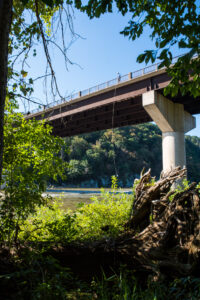The Virginia Department of Health issued a Harmful Algae Bloom (HAB) Advisory for a 53-mile stretch of the North Fork of the Shenandoah River on August 10, 2021 (Figure 1, left). Samples from multi-species algal mats on the river bottom contained harmful levels of toxins produced by cyanobacteria. Three weeks later, Tropical Storm Ida passed over the North Fork, dumping torrential rain on the watershed. Sharply rising streamflows were expected to scour the benthic algal mats, potentially lysing their cells and releasing toxins as they washed downstream. The ICPRB’s Emergency River Spill Model (ERSM) indicated the scoured material’s leading edge would reach the Potomac River mainstem by September 2nd – 4th and Great Falls near Washington, D. C. by September 3rd – 6th.
Virginia Department of Environmental Quality staff confirmed the algal mats were scoured off the river bottom. Water samples collected by ICPRB at the Shenandoah River mouth indicate the storm’s high flows diluted the algal cells and their associated toxins to below-detection levels before they reached the Potomac River. If flows had been less intense, we hypothesize the scoured material and toxins could potentially have reached the Potomac River mainstem. More advanced flow modeling and additional sampling during algal blooms could better characterize the potential transport of scoured or senescing algal blooms in the Shenandoah River under different river conditions.

